
Termites love to feast on decaying and dead tree matter. They also reproduce at an alarming rate and the queen termites can live and keep reproducing for more than 25 years. This means that even a small colony can easily wreak havoc on your house within a period of 3 to 5 months. One of the main signs of termite infestation of your house is termite droppings or frass.
Drywood termites and Subterranean termites
The two main types of termites that commonly damage houses in America are drywood termites and subterranean termites.

Drywood termites
Drywood termites are generally found flourishing in areas with high levels of humidity. They often reside in small colonies and do not need direct access to soil. Thus, they can easily tunnel into varied house structures located above the ground. They find crevices, gaps, or small cracks in wood and enter the house via them. Then, they seal themselves in such gaps and make nests for purpose of laying eggs.
They are generally found in the warmer regions of the country. They may also gain entry into the house via everyday human or business activities, as they are occasionally present in contaminated foodstuffs or cargo shipments. Drywood termites are known to be the main culprits with regards to termite destruction of homes in the US.
After some drywood termites create a small nest inside wood, they seal the opening used for entering into the wood and do not leave the place. All the necessary conditions required for their survival and growth, i.e., food, shelter, water, and ideal temperature, are present in their nest inside wood. The only think that is lacking is space. Hence, as they eat wood, they make kick-out hole (exit hole) which are then used to remove termite droppings out of the nest and keep it clean.
Drywood termite droppings are oval-shaped tiny pellets or capsules with rounded tips and 6 concave sides. The feces/frass can be of varied colors as per the color of wood that is being consumed by the termites. The termite droppings measure around 1 mm in length, and several of them together form into tiny mounds on the ground next to the exit holes. These mounds of termite droppings may seem like small piles or pepper or salt.

Subterranean termites
Subterranean termites like to live inside the soil. They tend to live in bigger colonies as compared to drywood termites. They liking living underground and typically enter homes from the ground level. They are very difficult to find as they chew their way upwards the foundation of houses and into the main structure.
Subterranean termites often attack houses in those sections of the building where the wood makes contact with the soil, like door frames, porches, and supports. They may even invade via sections where concrete or brick makes contact with wood. These termites are found in all areas of the US, with the exception of Alaska.
This species of termites usually do not leave termite droppings that are easily visible. One of the first signs of an infestation by subterranean termites is the formation of muddy worm-like tunnels that run up and across foundations or walls. These termites use their droppings to construct the mud tubes or tunnels. Hence, it is quite difficult to differentiate their nest from their termite droppings.
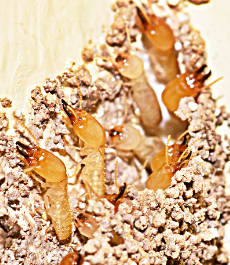
Health risk of Termite Droppings
Termite poop is not known to cause health issues, but it may cause skin irritation to some people when there is contact with the skin.
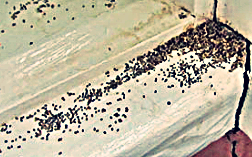
Other signs of termite infestation
Besides termite droppings or frass, there are other signs that homeowners can look for to confirm a termite infestation. They are as follows:
- There may be alterations on the wooden surfaces of the house. Infestation by termites generally leaves signs such as uneven walls, bubbling paint, or other kinds of ripples on walls which were not present before.
- Homeowners may tap the wood surfaces in their homes and check for any hollow sound. It may be noted that any kind of damage to wood, including presence of hollow areas inside the wood, can be easily found by tapping on wooden surfaces and listening for an echo or hollow sound. The extent of damage to the wood is directly proportional to the hollowness of the sound.
- Presence of swarming termites or shreds of wings which have been shed is another sign of a termite infestation. Wings which have been recently shed indicate an active termite colony. The shed wings may be located in a pile and each one may look like tiny fish scales.
- In case of infestation by subterranean termites, one of the common signs is presence of mud tubes on sections of wooden structures that are closer to the level of the ground. These tubes can be nearly as wide as a pen/pencil.

Eradication of termite droppings and termites from homes
Termites can cause extensive damage to homes and very expensive repair and reconstruction work subsequently. It is therefore important to immediately seek the assistance of a pest control professional or an exterminator to get rid of termites from the house at the earliest. Avoid getting rid of termites from the house on your own, because if you are not able to eliminate the infestation, then the resulting delay will only cause more structural damage and increased repair costs.
Termite exterminators will first carry out an assessment of the extent of infestation and damage. They will thoroughly inspect the house and check crawlspaces and basement for dampness, the foundation for any wood debris, and other vulnerable places which may have been attacked by termites.
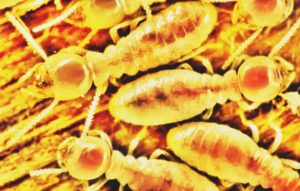
After the examination is over, they will carry out one or all of the following treatments to kill the termite colonies and eradicate them from the house.
- Dry foam is used to clear and treat gaps in external and internal walls, under slabs, around water pipes and heating ducts, and other surfaces that are hard to reach.
- Liquid termite solutions may be safely used outdoors as well as indoors as well as inside the foundation to offer a protective fence around the house. This not only eradicates current termite infestation, but also helps prevent any infestation in the future.
- Sentricon bait treatment is used on areas that are most attractive for termites like mulch, moist soil, irrigation sprinkler heads, old tree stumps, and downspouts. It upset the molting process of termites and stunts their growth.
After the above treatments are complete and the termite colonies are destroyed, the exterminators will monitor your house for a relevant period of time to confirm whether or not there is occurrence of a new infestation by termites.


Leave a Reply